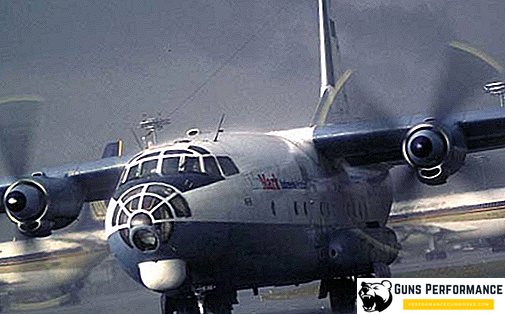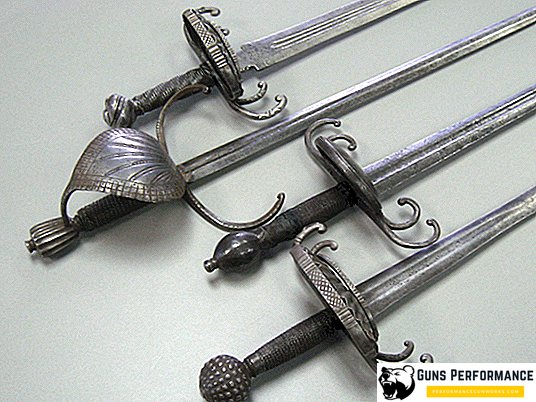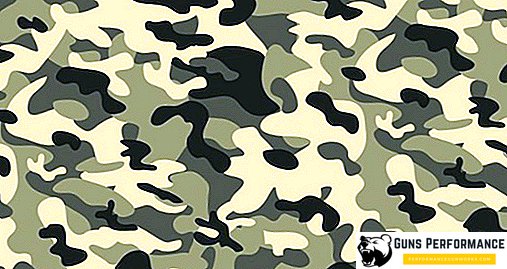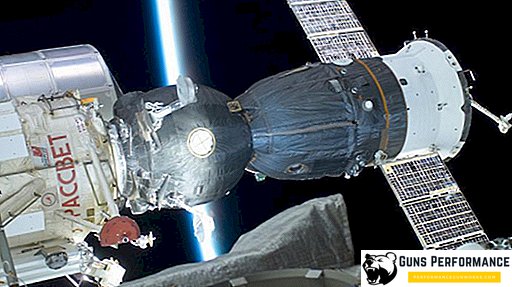In Nazi Germany, a large number of a wide variety of self-propelled artillery mounts (SAU) was created. The Germans were able and loved to do self-propelled guns, on the Eastern Front, their main task was to fight with Soviet tanks (KV, T-34). The most famous machine of this class (at least in Soviet historiography) is the Ferdinand assault gun (Sd.Kfz.184). After the modernization, which was carried out in 1943, this self-propelled gun got its second name - "Elephant".
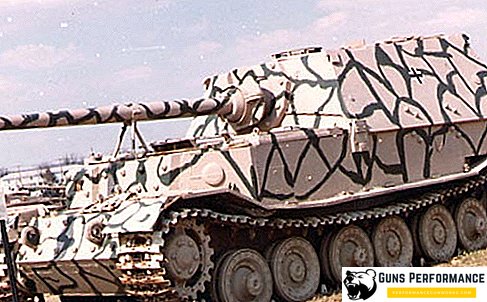
This creation of the gloomy genius Ferdinand Porsche, without any doubt, can be called a masterpiece of engineering thought. The technical solutions that were used to create this ACS were unique and had no analogues in tank building. At the same time, "Ferdinand" was not too adapted for use in real combat conditions. And it's not even the "childhood diseases" of this car. The low mobility, low power reserve and the complete absence of the concept of using ACS on the battlefield made Ferdinand practically unsuitable for real use.
In total, only 91 "Ferdinand" were released - a miser compared with other German self-propelled guns. Why did this car become so widely known? How did she frighten the Soviet tankers and gunners so much that in almost every military report they pointed out dozens of Ferdinands when they were not there?
For the first (and last) time the Germans massively used "Ferdinands" during the battle of Kursk. The debut of the car was not too successful, especially “Ferdinand” proved to be very bad in the offensive. However, despite all the flaws, Ferdinand was a terrible opponent. His phenomenal armor protection did not break through. Nothing at all. Imagine how Soviet soldiers felt when they fired a projectile after a projectile into an armored monster, which, without paying any attention to it, continued to shoot at you.

After the fighting on the Kursk Bulge, the Germans took the self-propelled guns from the Eastern Front, the next time the Soviet troops met with a large number of "Ferdinands" only during the fighting in Eastern Europe. However, despite this, the Soviet fighters stubbornly continued to call all German self-propelled guns "Ferdinands".
If we sum up all the "Ferdinands" destroyed by the Soviet reports, then we get several thousand self-propelled guns. True, a similar situation developed with the Tigr tank: the lion’s share of wounded German tanks in the reports of Soviet tankers turned into Tigers.
His first shots “Ferdinand” made at Kursk, and he ended his fighting way on the streets of Berlin.
History of creation
The history of the heavy anti-tank (PT) self-propelled installation "Ferdinand" began during the competition for the creation of another legendary German car - the tank "Tiger I". Two companies participated in that competition: Henschel and Porsche.

On Hitler’s birthday (April 20, 1942), both companies presented their prototypes of the new heavy machine: VK 4501 (P) (Porsche) and VK 4501 (H) (Henschel). Hitler favored Ferdinand Porsche so much that he almost did not doubt his victory: before the end of the tests, he began production of a new tank. However, the staff of the Arms Directorate treated the Porsche quite differently; therefore, the Henschel machine was declared the winner in the competition. Hitler believed that two tanks should be adopted at once and produced in parallel.
The VK 4501 (P) prototype was more complicated than its rival, it used very original design solutions, which is probably not too good for a wartime tank. In addition, the production of the Porsche tank required a large number of scarce materials (non-ferrous metals), which was a powerful argument against the launch of this car in the series.
Another important event that had a direct impact on the fate of this self-propelled gun, was the emergence of a powerful new anti-tank gun 88-mm Pak 43.
The readiness for production of a new Porsche tank was higher than that of a competitor, by the summer of 1942 the first 16 VK 4501 (P) tanks were ready. They were planned to be sent to Stalingrad. However, by the decision of the same Directorate of Armaments, all work was suspended. In the fall of 1942, the Office’s officials decided to convert all the ready-made VK 4501 (P) tanks into assault guns armed with a new cannon.

Work on reworking the tank into a self-propelled unit began in September 1942 and they took quite a lot of time. The designers had to completely change the layout of self-propelled guns. The armored cabin of the new machine was placed aft, so the power plant had to be moved to the central part of the car, new engines were installed, which led to a complete rework of the entire cooling system. The front part of the hull and the battle was strengthened, the thickness of its armor was brought to 200 mm.
All work was carried out under the conditions of the most severe time trouble, which did not in the best way affect the quality of the ACS. The design and rework of the first machines was carried out at the Alkett plant, but then the work was transferred to the Nibelungenwerke plant. In order to demonstrate once again his position towards Ferdinand Porsche, Hitler personally assigned the new ACS the name Ferdinand at the beginning of 1943.
In the spring of 1943, the first self-propelled artillery installations "Ferdinand" began to arrive on the Eastern Front.
At the end of 1943, machines that survived the Battle of Kursk (47 units) were delivered to the Nibelungenwerke plant for modernization. A machine gun in a ball mount appeared on the front plate, the gun barrels were replaced, a commander’s turret with seven periscopes was installed on the wheelhouse, the armored landing gear was reinforced, the SAU was equipped with wider tracks. It was after the modernization of the ACS that it got the name “Elephant”, although it got acclimatized badly and until the very end of the war these self-propelled guns were called “Ferdinands”. In the domestic historical literature there are both names, although the most common, of course, is "Ferdinand". In the English-language literature, on the contrary, this ACS is often called the "Elephant", because it was the troops of the allies who dealt with it at the final stage of the war.
Combat use
For the first time, the Germans massively used the ACS Fernand during the operation "Citadel", which we used to call the Battle of Kursk.

Prior to the start of the operation, all SAUs were sent to the front and included in two heavy anti-tank battalions. They were placed on the north face of the Kursk bulge. As conceived by the German strategists, powerful and invulnerable self-propelled guns were to play the role of the tip of a heavy armored spear that rammed Soviet positions.
Soviet troops on the Kursk Bulge created a powerful echeloned defense, securely covered with artillery and minefields. Attacking tanks were fired from all possible calibers, including 203-mm howitzers. Maneuvering, self-propelled guns were often undermined by mines and land mines.
During the battles for the railway station Ponyri, the Germans lost several dozen Ferdinands. In total for the period from July to August 1943, losses amounted to 39 cars.

There is a theory that most self-propelled guns suffered from the actions of the infantry, as the developers did not equip the SAU with a machine gun. But, if we look at the reasons for the loss of the Ferdinand self-propelled artillery system, it becomes clear that most of the vehicles were blown up by mines or were destroyed by artillery fire. There were losses due to technical faults. The Germans could not evacuate the wrecked "Ferdinands" due to the lack of suitable evacuation means: this machine weighed too much. Therefore, even the slightest damage led to the loss of the car.
Even the not very skillful (from a tactical point of view) use of the “Ferdinands” had a great psychological effect. The appearance on the battlefield almost invulnerable self-propelled guns led to the development of this "Ferdinandophobia." These self-propelled guns appeared to Soviet soldiers everywhere, in some "memories" they are found even before 1943.
Much more effectively acted “Ferdinand” in defense. After the end of the Battle of Kursk, the remaining cars were evacuated to Ukraine, where they took part in the defense of Dnepropetrovsk and Nikopol. In these battles, four more self-propelled guns were lost. Then SAU were sent to Germany for modernization. According to German data, at the end of the autumn of 1943, Ferdinands destroyed nearly 600 Soviet tanks and more than a hundred artillery pieces. However, these data by many historians are being questioned.
After modernization, the Elefants fought in Italy, in Western Ukraine, in Germany. The firepower of the Soviet troops increased, in the final phase of the war the Red Army had a significant quantitative superiority over the Wehrmacht. The battlefield was usually left to the Soviet troops, which forced the Germans to blow up even slightly damaged Elephanta.

The Soviet troops effectively used heavy SPGs against the Elephant (the SU-152 was particularly effective) and anti-tank artillery.
After heavy fighting in Western Ukraine and in Poland, the remaining Elefants were withdrawn to the reserve.
In 1945, "Elephanta" participate in battles in Germany, and their last battle was three "Elephanta" they gave in surrounded Berlin.
Description
SAU PT "Ferdinand" was intended for the destruction of enemy armored vehicles. His crew consisted of six people: the commander of the gun, two loaders, a radio operator (on the Elephant - a machine gunner) and a gunner.

The layout of the ACS was somewhat unusual: the fighting compartment was located in the spacious fighting room, which was located at the stern. The engine, along with the generators, fuel tanks and cooling system, was located in the center of the car, and the control compartment occupied the front of the self-propelled gun.
In the control compartment were places for the radio operator and the driver. They were separated from the conning tower by two heat-resistant partitions of the power compartment, and could not get into it.
The body of the ACS consisted of rolled armor plates, the thickness of which in the frontal part reached 100 mm, in the side part - 80 mm. In addition, the frontal part of the hull and wheelhouse was reinforced with additional plates, which were fastened with the help of bolts with a bullet-proof head. Also, 30-mm armor plate was reinforced front part of the bottom. The steel, which was used to manufacture self-propelled guns, was taken from fleet stocks and was distinguished by high quality.
In the aft part of the cabin there was a security door, which was used to replace the gun and for emergency evacuation of the crew. In the roof of the cabin there were two more hatches, places for the installation of sighting devices and observation devices, as well as air vents.
The main weapon "Ferdinand" was a 88-mm gun StuK 43 (or PaK 43) with a length of 71 caliber. The gun had a two-chamber muzzle brake; in the march the barrel rested on a special mount. Guidance was carried out with the help of the SFlZF1a / Rblf36 monocular sight.

The gun "Ferdinand" had excellent ballistics, at the time of its appearance was the strongest among the tank and artillery guns of all countries participating in the conflict. Until the end of the war, Ferdinand easily hit all tanks and self-propelled guns on the battlefield. The only exceptions were the IS-2 and the Pershing, whose armor at some distances could withstand hits from the PaK 43 projectile.
The Ferdinand power plant was distinguished by its original design: two carburetor 12-cylinder Maybach HL 120 TRM engines were driven by two electric generators that fed the Siemens D1495aAC electric motors. Each motor rotated its own drive wheel.
Chassis consisted of three two-wheeled carts, drive and guide wheels. Combined suspension, it consisted of torsions and rubber pads. The width of the tracks "Ferdinand" was 600 mm, "Elephant" "pereobuli" in wider tracks - 640 mm.
Machine Evaluation
The self-propelled gun Ferdinand is a machine that has earned rather mixed assessments both among contemporaries and later researchers.

First of all, this self-propelled gun can be called an experimental project, which was created on the basis of a prototype tank. Many innovative technical solutions were used on this machine, which was not a good idea for a war machine. Electric transmission and suspension with longitudinal torsions proved to be very effective, but very complex and expensive to manufacture. Do not forget that the products of wartime are always inferior in quality to the equipment made in the peace period. Therefore, during the war, it is better to give preference to simpler weapons.
It should also be noted that the Ferdinand electrical equipment required a lot of copper, which was deficient in the Third Reich.
Most likely, the Germans did not engage in the production of "Ferdinand", if Porsche did not have a significant number of ready-made chassis, with which it was necessary to do something. However, after using them, the production of self-propelled guns was curtailed.

If we talk about the fighting qualities, the armor protection made the SAU virtually invulnerable to the fire of the tanks and anti-tank artillery of the allies.
Only at the end of the war, Soviet tanks IS-2 and T-34-85 could expect to hit the Ferdinand from close range when fired at the side. Gunners were instructed to hit the self-propelled vehicle chassis. The most powerful gun self-propelled German without any problems affecting any type of enemy armored vehicles.
However, all of the above was leveled by the low mobility of the machine, its weak maneuverability. "Ferdinand" could not use many bridges, they simply could not withstand its weight. In addition, the reliability of the machine left much to be desired, and many technical problems were not solved until the end of the war.


Specifications
Below are the technical specifications of the Ferdinand self-propelled artillery.
| Combat weight | 65 t |
| Length | 6.80 m |
| Width | 3.38 m |
| Height | 2.97 m |
| Crew | 6 people |
| Armament | 1x88mm Pak-43/2 gun; |
| 1 × 7.92 mm machine gun | |
| Ammunition | 50 shells |
| Booking | up to 200 mm |
| Engine | 2x Maybach HL 120 TRM |
| Speed | 30 km / h |
| Power reserve | 150 km |



